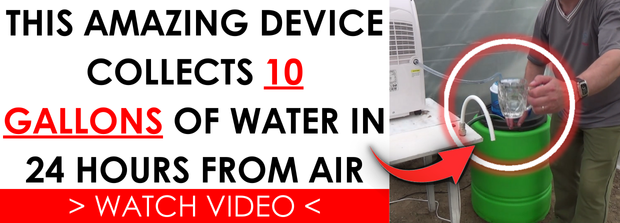Surviving the Flood You Didn’t Plan For – Survivopedia

I sit here in my office, looking out through the window at a thunderstorm, right in the middle of a drought. Mother Nature likes to play tricks on us, and this is just one example of the tricks she has up her sleeve. There’s nothing that says individual weather events don’t have to line up with overall weather patterns; and even if there were, Mother Nature probably wouldn’t pay attention.
This is the third… or is it the fourth, thunderstorm we’ve had this week – after a couple of month long dry spell. We can sure use the rain, but I really wish that it was falling about 100 miles upstream. Our reservoir is down to 17% of its capacity and the rain we’ve received this week won’t do anything to help fill it up. Instead, it will flow downstream into the Gulf of Mexico, not helping humans at all in our struggle for survival. And the fish won’t even notice the extra water.

Even though we’re only 35 miles from the coast, we’re a good 161 feet above sea level. That might be enough to protect us from hurricane storm swells and even tsunamis, but it doesn’t mean that we’re totally impervious to flooding. Flash flooding is commonplace in Texas, and we’re not immune here. My properly is well sloped, with the house a couple of feet above street level and on top of that, we’re on pier and beam, which makes us fairly safe. But I can’t say the same thing for everyone in town. There are houses just a few blocks from us, which have a tendency to flood.
Actually, although my house is safe, my garage workshop isn’t. every time we get a heavy rain, I get water seeping under the garage doors and the wall. I’ve positioned things in the workshop to be protected from the water, but I hate to think of just what this is doing to the structure of my wall.
Let’s Redefine Flooding
At the worst end of the scale, flooding can refer to Noah’s flood in the Bible. That was probably the worst flood the world has ever seen, regardless of how you interpret scripture. Whether it was a localized flood or one that spanned the globe, a flood that covered up mountains, even little mountains, s quite a flood.
When most of us think of flooding, we think of water several feet deep, covering the entire ground. I’ve seen floods in the state of Tabasco, Mexico which ranged anywhere from two feet deep up to ten feet deep. The flooding wasn’t just in one or two houses; it covered whole sections of the city. People who had two-story homes had to move everything upstairs, while those who had one-story homes lost everything. Abou the only thing that was usable after the flood was the structure itself, since it was made of cement and cinder block. They could dry it out and repaint; but everything inside was destroyed.
While that’s clearly a flood, that’s not the only thing that can be considered to be a flood. The water that seeps under my garage wall is a flood as well, just not as serious a one. What makes it bad isn’t the severity of the flooding, but the frequency of it. I can count on that water getting into my workshop a good six to eight times a year, enough to cause some rather serious damage.
So, whether or not conditions are “flood conditions” for anyone else is totally immaterial, when you’re talking about whether or not your home has flooded. If your basement turns into an indoor swimming pool, even a kiddie pool, your house has flooded. Worse than that, from a prepping point of view, is that whatever you have stored in your basement, which probably means your stockpile, has quite possibly been ruined.
Evaluating the Situation
While the type of flooding I’m experiencing in my workshop isn’t anything serious enough to be called a survival situation, it is something of concern. Specifically, my concern is for the structural integrity of my home. Considering that my home is my shelter, I need it to remain structurally sound for my family’s continued survival. Any damage to the tools and other things in my workshop is secondary to that.
The same can be said for your home. So, the question is… is your home under risk of flooding, even the minor flooding that I’m referring to? If you live in what’s known as a “100-year flood zone” that’s definitely true. But you don’t have to be living in such a place for your home to be at risk of flooding. As I mentioned earlier, there are homes down the road from me which flood. That’s not because they are in flood zones; but rather, because they are build on a slab that’s sitting right on the ground. They had been built before the building code required that the ground under a house be built up, so that it was high enough above the street level to prevent flooding.
If you haven’t done so, talk a good walk outside during the next heavy storm. Look at how the water is draining and whether it is pooling anywhere on your property. Pay particular attention to any pooling that is up against your home or your home’s foundation. That pooling might indicate a potential entry point for water getting into your home.
Preventing Flooding
Once you’ve determined areas of your home which might experience flooding, the next step is to find a way to protect those areas. In the case of my workshop, the amount of water flowing over the driveway, which causes flooding is actually quite minimal, never reaching ¼ inch deep. So, all I need is something to form a dam, just outside my wall and garage door, which will block that water from getting in. Fortunately, such things already exist. I can solve the problem with a garage door seal kit.
But that wouldn’t work, if I was dealing with several inches of water standing outside my garage door. In that case, I’d need to construct a higher dam, which would channel water away from my garage and keep it from entering. There are many ways that I could do that, with concrete, sandbags or even the water-filled tubes that they use for flood control. As a low-tech alternative to those tubes, I could fill plastic bags with water and anchor them across my garage door.
Of course, the higher the potential flooding, the more effort has to be put into preventing it. There have been extreme cases where families have built three-foot-high sandbag walls around their homes to protect their property from a pending flood. That’s a lot of work and a lot of expense; but in the larger scheme of things, it’s cheaper and easier than replacing or rebuilding their home. If you don’t believe me, just ask any of the people who lived in southwest Houston during Hurricane Harvey.
Preparing for Flooding
Okay, so you’ve done the best you can, to keep that water out of your house. How do you know your efforts are going to work? You don’t. That’s the problem. Even the best of efforts can fail, if conditions are worse than you expected or conditions change from when you developed your flood-prevention plan. All it takes is one neighbor, upstream of you, to do something to protect their home, sending more water your way, to invalidate everything you’ve done.
The most susceptible part of any of our homes is our basements, assuming you have one. I don’t and can’t, due to where I live. The water table is too high here, so any basement would end up flooding, even without a storm to dump several inches of rain on us.
If I had a basement, I’d probably have most of my stockpile and other supplies and equipment associated with prepping stored in it. That would mean that just about everything I need to survive would be in the most flood-prone part of my home. I would have to pack it carefully, to ensure that it did not get wet, even if my basement filled with water.
Fortunately, there are a number of different ways of doing this. One, which is commonly used in the prepping community is five-gallon plastic buckets. These are great for more than just storing bulk food in. You can store just about anything in them, which will fit inside, allowing you to close the lid.


Plastic bins aren’t anywhere near as good as those buckets; but they will work for some items. Those bins are likely to float, so unless your basement fills to the ceiling with water, they’ll probably keep things dry. This is especially good for those things that won’t be ruined by getting wet, even though we don’t want them to get wet.
But what about things that need to stay dry, but won’t fit in five-gallon buckets? The military solved that problem before any of us were born, back in World War II. That’s when the military started including in their specifications that moisture and water sensitive items be packed in plastic.
When we’re talking plastic here, we’re not just talking about wrapping it in plastic and taping it shut. That’s obviously not waterproof. But one of the great things about plastic sheeting is that it can be heat sealed. Thousands, if not millions, of tons of military equipment and supplies were shipped to the Pacific and to Europe wrapped in heat-sealed plastic to protect those supplies from damage.
We can do the same things. I recommend starting out with some fairly thick plastic sheeting, the heaviest visqueen you can find. You’ll have to experiment a bit with heat-sealing it; but I’ve done it successfully by using a hair straightener or a clothes iron, just like heat-sealing bags of food to go into those five-gallon plastic buckets. Once you figure out the right heat setting and how fast to move, it’s actually rather easy to flood-proof any of your survival gear and supplies.
Read the full article here






